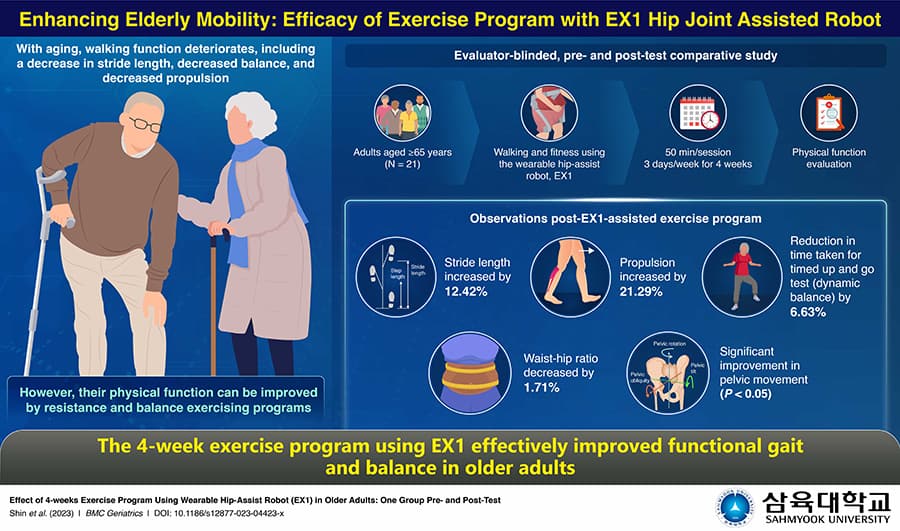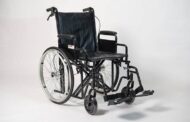By Sarah Sarsby
AT Today ,February ,2.2024
In a study, researchers from Korea evaluated the efficiency of a new wearable robot, EX1, in improving the mobility, dynamic balance, and range of movement in elderly people.
The results show that EX1 can effectively improve functional gait among and mitigate the risk of falls among older adults.
Samsung Electronics developed the EX1 exercise assistance robot, with the goal to amplify physical function and strength in senior individuals. This robotic aid offers tailored workouts with both assistive and resistive modes, aiming to prevent falls and bolster overall health in this demographic.
Led by Professor Wan-hee Lee from Sahmyook University College of Health Science in Korea, a collaborative team of researchers, Noble County, and Samsung Electronics assessed the effectiveness of EX1 in executing a four-week combined exercise program for older adults.
Entitled ‘Effect of 4‑weeks exercise program using wearable hip‑assist robot (EX1) in older adults: one group pre‑ and post‑ test’, their study is published in BMC Geriatrics.
Highlighting the importance of EX1, Prof. Lee explained: “Using the wearable robot EX1, older adults can effectively perform simple exercises such as walking and fitness, thereby improving their quality of life. EX1 can increase their participation in exercise and serve as a guideline for exercising the right way.”
The team designed an evaluator-blinded, pre- and post-test comparative study to analyze the effectiveness of EX1. A total of 21 older adults, aged 65 years or above, performed a supervised exercise program consisting of walking, and strength, and balance exercises, wearing EX1 for 50 minutes per session, three times a week for four weeks.
To compare pre- and post-exercise attributes, the spatiotemporal parameters, and pelvic movement were analyzed by G-Walk. Additionally, functional outcomes were evaluated by timed up and go test (TUG), muscle power by rehabilitative ultrasound imaging (RUSI), and waist-hip ratio by Inbody 770.
Following the exercise regimen, significant improvements were noted in various spatiotemporal factors: the stride length increased by 12.42 percent, and the propulsion increased by 21.29 percent, suggesting improved walking ability.
The TUG test revealed a 6.63 percent decrease in completion time, indicating improved dynamic balance and expanded movement range among participants. Additionally, there was a notable 1.71 percent reduction in the waist-hip ratio after the four-week exercise period.
While the statistical significance of the increased walking speed was not confirmed, a noticeable enhancement, especially during mid-walking, was attributed to the assistive mode of EX1. This mode notably improved stride length, affecting forward movement in straight walking.
Moreover, pelvic movement in three planes significantly improved, aligning within normal ranges, fostering efficient walking by reducing energy consumption and bolstering stability through extended feet and a lower body center.
The exercise program also positively impacted one-leg standing endurance, potentially due to strengthened hip-centered muscles crucial for fall prevention among older adults. Analysis of muscle activity revealed heightened activation of core muscles during walking, likely influenced by EX1’s waist support, contributing to trunk stability maintenance.
These findings suggest that although the four-week exercise period was relatively short for older adults and did not notably enhance muscle strength, EX1 still displayed positive effects on improving gait function and balance ability in this population.
Professor Lee concluded: “Our findings provide a solid foundation for developing various types of improved and advanced wearable robots. This will further expand the global wearable robot market, promoting further research and commercialization.”

Sarah Sarsby
Digital Content Editor
Sarah joined BHTA Engage who produce (THIIS Magazine, AT Today) in April 2018 as the new Content Writer and Marketing Assistant.
After graduating with a Masters in English Language from De Montfort University, Sarah will be working on all BHTA Engage publications and help ing develop new activities.
Sarah has many different hobbies and interests, she enjoys writing and cooking in her spare time. She also likes to stay active by swimming and practicing yoga.
Digital Content Editor
020 3833 0792

























